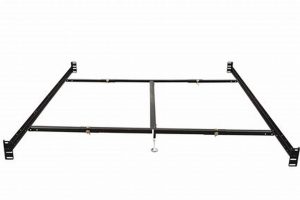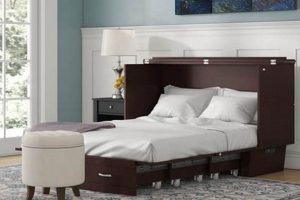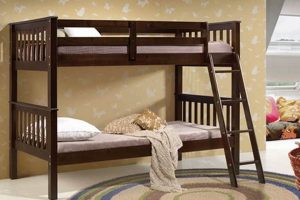The perfect sleeping surface, optimized for individual comfort and support, represents the pinnacle of bedding technology. This ideal promotes restful sleep, proper spinal alignment, and pressure relief, ultimately contributing to overall well-being. For example, a product might utilize advanced materials and construction techniques to minimize motion transfer and regulate temperature.
The benefits of an optimized sleep environment are numerous, ranging from improved cognitive function and mood to reduced pain and enhanced physical recovery. Historically, advancements in materials and design have continuously striven to create this optimized sleep surface, evolving from simple straw mattresses to sophisticated, multi-layered constructions incorporating memory foam, latex, and innerspring systems. This evolution reflects a growing understanding of the correlation between sleep quality and overall health.
The following sections will explore specific aspects of achieving this optimal sleeping solution, including material science, construction methods, support systems, and factors influencing individual comfort preferences, providing a comprehensive guide to understanding and selecting the ideal sleeping surface.
Selecting an Ideal Sleep Surface
The selection of a suitable sleep surface necessitates careful consideration of individual needs and product characteristics. The following tips provide guidance for navigating the selection process.
Tip 1: Assess Individual Support Needs: Evaluate body weight, sleeping position, and any existing musculoskeletal conditions. Individuals with back pain may require a firmer support system, while side sleepers often benefit from a more contouring surface.
Tip 2: Research Material Properties: Different materials offer varying levels of support, pressure relief, and temperature regulation. Memory foam conforms to the body, latex provides responsiveness, and innerspring systems offer traditional support. Consider the trade-offs of each material.
Tip 3: Consider Construction Quality: Examine the layering and construction techniques employed in the product. Reinforced edges, quilted covers, and durable stitching contribute to longevity and prevent sagging.
Tip 4: Evaluate Temperature Regulation: Consider the product’s ability to dissipate heat. Materials like gel-infused memory foam, open-cell foam, and breathable fabrics can help prevent overheating during sleep.
Tip 5: Investigate Motion Isolation: If sharing the sleep surface, motion isolation is a critical factor. Products with individually wrapped coils or dense foam layers minimize motion transfer between partners.
Tip 6: Review Warranty and Trial Period Policies: Reputable manufacturers offer warranties that protect against defects and trial periods that allow for in-home testing. Review these policies carefully before purchasing.
Tip 7: Read Independent Reviews: Consult independent product reviews from reputable sources to gain insights into real-world performance and durability.
Selecting an optimal sleep surface requires a comprehensive assessment of individual needs and product attributes. Prioritizing support, material properties, construction quality, temperature regulation, and motion isolation are crucial steps in achieving restorative sleep.
The following sections will delve into specific considerations for optimizing sleep hygiene and maximizing the benefits of the selected sleep surface.
1. Personalized Support System
A personalized support system within a sleep surface directly influences sleep quality and restorative potential. The effectiveness of any sleep surface in achieving its intended purpose is contingent upon its ability to adapt to the individuals unique physical characteristics. This includes considerations such as body weight distribution, spinal curvature, and preferred sleeping posture. An inadequate support system can lead to spinal misalignment, pressure point build-up, and subsequent discomfort, disrupting sleep cycles and hindering recovery. For instance, a side sleeper requires a surface that allows the shoulders and hips to sink slightly, maintaining spinal alignment. A universal, non-adaptive surface will fail to provide this necessary contouring, resulting in potential shoulder or hip pain and compromised sleep quality.
The integration of advanced technologies and materials allows for increasingly personalized support. Memory foam, for example, conforms to the body’s unique contours, distributing weight evenly and alleviating pressure. Zoned support systems, incorporating varying levels of firmness across different mattress sections, further enhance personalization. These systems cater to specific areas of the body, such as the lumbar region, which often requires additional support. Another aspect is the ability of air mattresses to have firmness level adjusted on either side of the bed. This is very important for partners who prefer different firmness levels. The development and implementation of such systems mark a significant advancement in sleep technology, addressing the inherent limitations of traditional, uniformly constructed mattresses.
In conclusion, the personalized support system is a critical component in achieving an ideal sleep surface. By accommodating individual needs and preferences, these systems contribute to improved spinal alignment, pressure relief, and overall sleep quality. The ongoing evolution of materials and construction techniques continues to enhance the potential for personalized support, reinforcing its role in promoting restorative sleep and overall well-being. Understanding this connection is fundamental for both consumers and manufacturers in pursuit of optimized sleep solutions.
2. Temperature Regulation
Temperature regulation is a critical determinant of sleep quality and the overall experience associated with an ideal sleeping surface. Maintaining a stable and comfortable thermal environment throughout the sleep cycle directly impacts the ability to achieve deep, restorative sleep. Deviations from this thermal comfort zone can lead to restlessness, awakenings, and a reduction in overall sleep efficiency.
- Material Breathability and Airflow
The breathability of mattress materials is essential for dissipating heat and moisture. Materials such as open-cell foam, latex, and natural fibers (e.g., cotton, wool) allow for greater airflow, preventing heat buildup. Conversely, dense, non-breathable materials like traditional memory foam can trap heat, leading to discomfort. For example, mattresses incorporating gel-infused memory foam aim to mitigate this issue by enhancing thermal conductivity and promoting heat dissipation, but breathability remains a crucial factor in achieving effective temperature regulation. The airflow is determined by the material and construction met
hod of a mattress. - Moisture Wicking Properties
The ability of a sleep surface to wick away moisture is another key aspect of temperature regulation. During sleep, the body releases moisture through perspiration. Materials that effectively wick moisture away from the body, such as wool or specialized synthetic fabrics, help maintain a dry and comfortable sleep environment. Conversely, moisture accumulation can lead to a damp, clammy feeling, disrupting sleep. For instance, some mattress covers incorporate moisture-wicking technologies to enhance breathability and improve thermal comfort. A dry mattress will promote better sleep.
- Thermal Conductivity of Materials
The thermal conductivity of mattress materials influences how quickly heat is transferred away from the body. Materials with high thermal conductivity, such as copper-infused foam or certain types of gel, dissipate heat more effectively than materials with low thermal conductivity. This property is particularly relevant for individuals who tend to sleep hot. Mattresses with integrated cooling technologies, such as phase-change materials (PCMs), can absorb and release heat, maintaining a stable temperature range throughout the night. Materials with low thermal conductivity can lead to heat buildup and overheating.
- Mattress Construction and Design
The design and construction of a sleep surface can significantly impact its temperature regulation capabilities. Open-coil innerspring systems, for example, promote airflow within the mattress, aiding in heat dissipation. Layered construction, incorporating breathable materials in the upper layers, can further enhance thermal comfort. Conversely, dense, tightly packed construction can restrict airflow and contribute to heat retention. The number of layers also plays a role in the transfer of heat. For this reason, manufacturers spend a lot of time thinking about this when designing the layering of a mattress.
The facets discussed contribute significantly to achieving effective temperature regulation in an ideal sleep surface. The interplay of these material properties directly impacts the sleep experience, with a well-regulated thermal environment promoting deeper, more restorative sleep. The construction material and the method in which a mattress is constructed are just a few key factors. Therefore, temperature regulation is a critical component in the quest for the ideal sleep surface, particularly for individuals sensitive to temperature fluctuations during the night.
3. Material Durability
The longevity and sustained performance of a sleep surface are fundamentally linked to the durability of its constituent materials. The concept of a “dream bed mattress” inherently implies long-term satisfaction and consistent quality, a characteristic directly influenced by the materials’ resistance to wear, degradation, and structural failure over time. Premature material breakdown can compromise support, comfort, and hygiene, undermining the initial investment and negating the benefits of an otherwise well-designed product. For example, low-density foam may compress and lose its support properties within a year, leading to sagging and discomfort, even if the mattress initially provided excellent pressure relief. Similarly, poorly constructed coil systems can break down or warp, creating uneven surfaces and diminishing support. Therefore, material durability is not merely a matter of cost-effectiveness; it is a crucial determinant of the long-term viability of a “dream bed mattress”.
The selection of durable materials necessitates a careful consideration of their inherent properties and performance characteristics. High-density foams, for instance, offer superior resistance to compression and deformation compared to lower-density alternatives. Tempered steel coils provide enhanced structural integrity and resist sagging. Natural latex, known for its resilience and elasticity, maintains its support properties over extended periods. The manufacturing processes also play a crucial role. For instance, proper curing of foams and precise assembly of coil systems contribute to the overall durability of the finished product. Furthermore, the use of high-quality fabrics and stitching in the mattress cover can prevent tearing, abrasion, and premature wear, further extending the lifespan of the mattress.
In summary, material durability is an indispensable attribute of a “dream bed mattress.” It directly impacts the long-term performance, comfort, and hygiene of the product. Selecting a mattress constructed with durable materials ensures a consistent and supportive sleep environment, contributing to improved sleep quality and overall well-being. Recognizing the significance of material durability empowers consumers to make informed decisions, safeguarding their investment and securing the benefits of a truly restorative sleep experience over an extended period.
4. Spinal Alignment
Maintaining proper spinal alignment during sleep is paramount to musculoskeletal health and overall well-being. The capacity of a sleep surface to facilitate this alignment is a defining characteristic of a high-quality sleeping solution and integral to the concept of a “dream bed mattress”. A sleep surface that compromises spinal alignment can lead to pain, stiffness, and long-term postural problems.
- Neutral Spine Position
A neutral spine position refers to the natural curvature of the spine when standing upright. During sleep, the goal is to replicate this position as closely as possible. This minimizes stress on the vertebrae, muscles, and ligaments. For instance, side sleepers require a surface that allows the spine to remain straight from the head to the hips, avoiding excessive curvature. Back sleepers benefit from a surface that supports the natural arch of the lower back. A “dream bed mattress” facilitates this neutral position, regardless of sleeping posture.
- Support and Contouring Balance
Achieving spinal alignment requires a balance between support and contouring. Support prevents excessive sinking into the sleep surface, which can lead to spinal misalignment. Contouring, on the other hand, allows the mattress to conform to the body’s curves, providing pressure relief and maintaining the spine’s natural alignment. For example, a mattress that is too firm may not provide adequate contouring, resulting in pressure points and spinal misalignment, particularly for side sleepers. A “dream bed mattress” strikes this balance, offering both support and contouring to optimize spinal alignment.
- Adaptability to Sleeping Position
Individuals adopt various sleeping positions throughout the night. A “dream bed mattress” must adapt to these changing positions, maintaining spinal alignment regardless of whether the individual is sleeping on their back, side, or stomach. This adaptability may involve features such as zoned support systems or materials that respond to pressure changes. For instance, a mattress with firmer support in the lumbar region can help maintain spinal alignment for back sleepers, while softer support in the shoulder and hip regions can accommodate side sleeping.
- Impact on Musculoskeletal Health
Consistent spinal misalignment during sleep can have significant long-term consequences for musculoskeletal health. It can contribute to chronic
back pain, neck pain, and stiffness. It can also exacerbate existing conditions such as sciatica or arthritis. A “dream bed mattress”, by promoting proper spinal alignment, helps prevent these issues and supports overall musculoskeletal health, contributing to a more restorative and pain-free sleep experience.
In conclusion, the relationship between spinal alignment and a “dream bed mattress” is undeniable. A sleep surface that effectively supports and maintains the spine’s natural curvature is essential for preventing pain, promoting musculoskeletal health, and achieving restful sleep. The facets discussed neutral spine position, support and contouring balance, adaptability to sleeping position, and impact on musculoskeletal health collectively define the capacity of a sleep surface to facilitate optimal spinal alignment, solidifying its role as a key component of a truly high-quality sleeping experience.
5. Pressure Point Relief
Pressure point relief is a crucial aspect of a sleep surface designed to facilitate restorative sleep and is, therefore, intrinsically linked to the concept of a “dream bed mattress.” Pressure points, which typically occur at bony prominences such as the hips, shoulders, and knees, experience concentrated forces when in contact with a sleep surface. Prolonged exposure to these forces can impede circulation, leading to discomfort, pain, and disrupted sleep. A “dream bed mattress” proactively minimizes these pressure points, fostering an environment conducive to uninterrupted and restful sleep. For instance, a mattress employing memory foam or latex conforms to the body’s contours, distributing weight more evenly and alleviating concentrated pressure on these sensitive areas.
The effectiveness of pressure point relief directly correlates with the materials and construction methods employed in the mattress. Materials with inherent conforming properties, such as viscoelastic foam or responsive latex, are particularly well-suited for this purpose. These materials adapt to the individual’s body shape, providing customized support and minimizing pressure buildup. In contrast, a sleep surface that lacks conforming properties can exacerbate pressure points, leading to discomfort and potentially contributing to the development or aggravation of conditions like bursitis or sciatica. The significance of pressure point relief extends beyond mere comfort; it is fundamental to promoting healthy circulation and minimizing musculoskeletal stress during sleep.
In conclusion, pressure point relief is not merely an ancillary feature but a core component of what constitutes a “dream bed mattress.” By minimizing concentrated forces on sensitive areas of the body, a mattress optimized for pressure relief promotes restful sleep, minimizes pain, and supports overall musculoskeletal health. Understanding this connection empowers consumers to make informed choices, selecting sleep surfaces that prioritize both comfort and long-term well-being. Failure to address pressure points can undermine the overall sleep experience, regardless of other features such as temperature regulation or motion isolation. Therefore, pressure point relief remains a critical consideration in the pursuit of an ideal sleep environment.
Frequently Asked Questions
This section addresses common inquiries regarding the selection, maintenance, and optimal utilization of a sleep surface designed to promote restful and restorative sleep.
Question 1: What key factors should be considered when selecting a sleep surface intended to facilitate optimal sleep quality?
Individual needs dictate specific requirements. Body weight, sleeping position, and any existing musculoskeletal conditions are primary considerations. Material properties, construction quality, temperature regulation, and motion isolation also warrant careful evaluation. Independent reviews and warranty policies offer additional insight.
Question 2: How does material composition influence the performance of a sleep surface?
Different materials offer varying degrees of support, pressure relief, and temperature regulation. Memory foam conforms to the body, latex provides responsiveness, and innerspring systems offer traditional support. The inherent properties of each material determine its suitability for individual needs.
Question 3: What are the potential benefits of a sleep surface designed to promote spinal alignment?
A sleep surface that supports proper spinal alignment can reduce back pain, neck pain, and stiffness. It can also improve overall posture and musculoskeletal health, contributing to a more restorative sleep experience.
Question 4: How can temperature regulation be optimized in a sleep environment?
Material breathability is paramount. Open-cell foams, latex, and natural fibers promote airflow. Moisture-wicking fabrics help maintain a dry and comfortable sleep environment. Cooling technologies, such as gel-infused foams or phase-change materials, can further enhance temperature regulation.
Question 5: How frequently should a sleep surface be replaced?
The lifespan of a sleep surface varies depending on its construction and materials. However, as a general guideline, replacement should be considered every 7-10 years. Signs of wear, such as sagging, unevenness, or reduced support, indicate the need for replacement.
Question 6: What measures can be taken to prolong the lifespan of a sleep surface?
Regular rotation of the sleep surface can distribute wear evenly. Utilizing a mattress protector safeguards against stains, spills, and allergens. Following the manufacturer’s cleaning instructions is essential. Avoid placing excessive weight or pressure on specific areas of the mattress.
Selecting and maintaining an optimal sleep surface requires careful consideration of individual needs and product characteristics. Prioritizing support, material properties, temperature regulation, and proper maintenance practices are crucial steps in achieving long-term sleep satisfaction.
The subsequent sections will explore advanced sleep technologies and emerging trends in sleep surface design.
Conclusion
This exposition has detailed the multifaceted nature of the “dream bed mattress”, moving beyond a simple product description to explore the underlying principles of support, temperature regulation, material durability, spinal alignment, and pressure point relief. These elements, when harmonized, converge to create a sleep environment that fosters restorative rest and enhances overall well-being. The discussion has emphasized the importance of individualized selection, informed by personal needs and a thorough understanding of available technologies.
The quest for the ideal sleep surface remains a dynamic field, driven by ongoing research and innovation in materials science and sleep physiology. Acknowledging the significance of sleep quality and its impact on individual health necessitates a commitment to continuous improvement and a willingness to embrace advancements that optimize the sleep experience. Prioritizing these factors will empower individuals to make informed decisions and invest in solutions that promote long-term sleep health.


![Finding the Perfect 3/4 Mattress for Antique Beds - [Bed Size Guide] Organic & Natural Mattress Buyer’s Guide: Non-Toxic Sleep Solutions Finding the Perfect 3/4 Mattress for Antique Beds - [Bed Size Guide] | Organic & Natural Mattress Buyer’s Guide: Non-Toxic Sleep Solutions](https://mattressworldpa.com/wp-content/uploads/2025/07/th-7119-300x200.jpg)



![Quick Air Bed Mattress Repair Kit: [Brand] Fixes Leaks! Organic & Natural Mattress Buyer’s Guide: Non-Toxic Sleep Solutions Quick Air Bed Mattress Repair Kit: [Brand] Fixes Leaks! | Organic & Natural Mattress Buyer’s Guide: Non-Toxic Sleep Solutions](https://mattressworldpa.com/wp-content/uploads/2025/07/th-7115-300x200.jpg)
